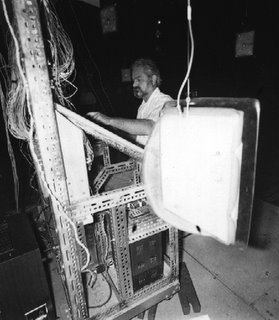 Click here
Click here for a post on Salvatore Martirano on Chroniques de la Mao. "I have just put on my blog an astonishing machine of Salvatore Martirano - American composer born on January 12, 1927 in Yonkers, New York, dead on November 17, 1995 - which I had taken in photograph in 1981 at the time of the international festival of Electronic Music, Video and Computer Art" The post includes an mp3 link, more shots and a link to The SAL-MAR Construction. Fascinating stuff. BTW, you might recognize the SAL-MAR Construction from this
post.
Update via deb7680:
"Thanks Matrix. Attention, the MP3 is not Salvatore Martirano but duet HplanK with synths (RSF and Ems Synthi Aks), guitar and computers (Apple II and first IBM PC) which I created in 1981. I evoked Hplank because it is the festival of the Plan K in Brussels which gave me the idea of the name of HplanK.
For the meetings, since 1971, I work in the arts centres and as a critic musical in the newspapers. It is my work. I was likely to meet a great number of composers, Pierre Boulez, Xénakis, Pierre Henry Morton Subotnick, musicians like John Mc Laughlin, David Murray, Soft Machine, Cure, Jean-Luc Ponty, Art Ensemble of Chicago, Sun Ra, etc...
See this :
http://www.deb7680.com/documentation/pierrehenry.pdf"
BTW, if you haven't already, check out
Chroniques de la Mao for a lot more on these subjects.




















































